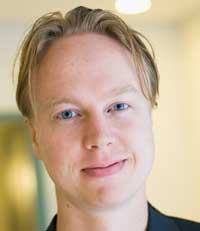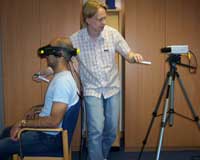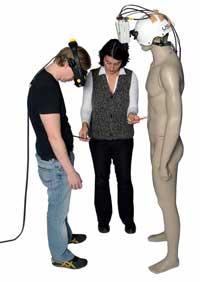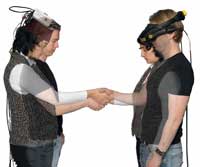Exploring out-of-body experiences: interview with Henrik Ehrsson Understand article
We’ve all sometimes felt ‘beside ourselves’, but have you ever felt that you were actually outside yourself – looking at yourself from outside your own body? Marta Paterlini talked to Henrik Ehrsson, a scientist studying this phenomenon.

Image courtesy of Henrik
Ehrsson
Out-of-body experiences (OBEs) have fascinated people for millennia – their existence has raised fundamental questions about the relationship between human consciousness and the body, and has been much discussed in theology, philosophy and psychology. An OBE occurs when a person who is awake sees his or her own body from a location outside the physical body. OBEs have been reported in clinical conditions where brain function is compromised, such as stroke, epilepsy and drug abuse, or in association with traumatic experiences such as car accidents. Around one in ten people claim to have had an OBE at some point in their lives.
However, the neuroscience behind this phenomenon remains obscure. Henrik Ehrsson, a 38-year-old cognitive neuroscientist at the Karolinska Institutew1 in Stockholm, Sweden, investigates how the brain represents the self, and has induced the phenomenon of OBE in healthy volunteers for the first time. He recreated an illusion in which individuals look at themselves from outside their physical bodies.
Henrik Ehrsson explains:
How do we recognise that our limbs are part of our own body, and why do we feel that our self is located inside the body? In my research, I am trying to identify the neuronal mechanisms that produce the sense of ownership of the body, and the processes responsible for the feeling that the self is located inside the physical body. Previously, there was no way of inducing an OBE in healthy people, apart from unproven reports in occult literature.
Could you describe your experiments?

experience
Image courtesy of Henrik
Ehrsson
The volunteers wear goggles with a video screen for each eye. Each screen is fed with images from a separate camera behind the volunteer and, because the two images are combined by the brain into a single image, the individual sees a stereoscopic (3D) image of his or her own back. We then move a plastic rod towards a location just below the cameras while the volunteer’s chest is simultaneously touched in the corresponding position. The participants reported feeling that they are located back where the cameras are placed, watching a body that belongs to someone else.
To test the illusion further and provide objective evidence, I then performed an additional experiment to measure the volunteers’ physiological response – specifically the level of perspiration on the skin – in a scenario in which they feel that their illusory body is threatened. Using a hammer, we ‘attacked’ a point below the cameras – a point where, according to the illusion, the volunteer’s body was located. The volunteer’s bodily response strongly indicated that he or she thought the threat was real: at the moment when the hammer ‘hit’ the illusory body, the volunteer sweated more. This demonstrates that the experience of being localised within the physical body can be determined by the visual perspective in conjunction with correlated multisensory information from the body.
Then you went further, successfully creating the illusion of body swapping by making volunteers perceive the bodies of mannequins and other people as their own, putting a male in a female body, a young person in an old body, a white person in a black body, and vice versa.

mannequin
Image courtesy of Staffan
Larsson
Yes, we presented evidence that the brain, when tricked by optical and sensory illusions, can quickly adopt another human form as its own, no matter how different it is. We designed two experiments. In the first one, the researchers fitted the head of a mannequin with two cameras connected to two small screens placed in front of the volunteer’s eyes, so that the volunteer could see what the mannequin ‘saw’.
When the mannequin’s camera eyes and the volunteer’s head, complete with the camera goggles, were directed downwards, the volunteer saw the dummy’s body where he or she would normally have seen his or her own body. By simultaneously touching the stomachs of both the volunteer and the mannequin, we could create the illusion of body swapping.
The volunteer could then see that the mannequin’s stomach was being touched while feeling (but not seeing) a similar sensation on his or her own stomach. Thus, the volunteer developed a powerful sensation that the mannequin’s body was his or her own.
In the second experiment, we mounted the camera onto another person’s head. When this person and the volunteer turned towards each other to shake hands, the volunteer perceived the camera-wearer’s body as his or her own. The volunteers saw themselves shaking hands, experiencing it as though they were another person. The sensory impression from the handshake was perceived as though coming from the new body, rather than the volunteer’s own.
The strength of the illusion was proved when the volunteers exhibited stress reactions after a knife was held to the camera-wearer’s arm but not when it was held to their own. However, the volunteers could not fool themselves into identifying with a non-humanoid object, such as a chair or a large block.

another human
Image courtesy of Staffan
Larsson
Did you detect any gender-based difference in the volunteers’ reactions?
We did not find any differences in gender. Everybody was very quick in recognising the new body. During one session, a very fit woman did not like the body of the scientist she swapped with, and was extremely relieved to be back in her own body. And one rather hairy male volunteer adapted well to being the mannequin but was shocked to realise how hairy he was, once he was back in his own body!
What kind of applications might your studies have in medicine or in general?
The knowledge that the sense of self-perception can be manipulated to make people believe that they have a new body can be used in virtual reality applications and robot technology, of course – for example, in the development of a prosthetic limb that feels just like a real limb, or as a method of controlling humanoid robots by the illusion of ‘becoming the robot’.
Inducing an OBE could also have industrial applications. This is essentially a means of projecting yourself – a form of cognitive ‘teleportation’. If we can project people into a virtual character, so they feel and respond as if they were really in a virtual version of themselves, just imagine the implications. For example, a surgeon could perform remote surgery, by controlling their virtual self from a different location.
When did you become interested in science? Did anyone in particular inspire you?
I started being interested in science very early, when I was 7-8 years old and my father gave me a microscope and a chemistry box. But there was not really a person [who inspired me]. The topic itself inspired me and books played a big role, really. Science was my major topic and I pursued medical studies with the idea that I wanted to become a scientist. As I became fascinated by the brain, instead of attending boring courses on the physiology and anatomy of the body, I craved books on consciousness and realised that so little was known about the brain and the mind.
What would you recommend to teenagers who would like to get into science? Do you have any tips about specific fields or career moves? Which qualities should a good scientist have?
I would recommend them to follow their hearts. Science is hard in the sense that you are supposed to solve problems and when you succeed you want to find and solve more problems. Sometimes it’s a struggle and the challenges seem insuperable. Passion is the trigger, but you also need a long-term, defined goal. It is a combination of curiosity, passion, knowledge, hard work and a bit of luck as well. Last but not least, the right environment, where you can grow, and the right financial and intellectual support.
Do you think that science will eventually explain everything?
Absolutely! It might take hundreds of years, but I definitely think that science will explain even such a complex matter as the human mind. Philosophers might not like it and still claim that there are unsolved questions about the mind, but we are deconstructing each component.
Web References
- w1 – To learn more about the Karolinska Institute, one of Europe’s largest medical universities, see: www.ki.se
Resources
- To learn more about Henrik Ehrsson’s research and download (free) the original research articles, see the website of his research group: www.ehrssonlab.se
Review
This article discusses out-of-body experiences and makes you think about what determines your feeling of self, encouraging you to think about what you really are, how you feel about your body, which concepts are generated purely by our minds, and how easy it is to trick the brain. The article makes you want to be part of the research group and have an out-of-body experience yourself.
In the classroom, the article could be used to discuss neurology and the human brain.
Andrew Galea, Malta





